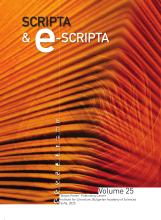This contribution aims to elucidate the relationship between strategies of audience involvement and emotional means of address in Gregory the Great’s (c. 540– 604) homilies on the gospels (Homiliae in Evangelia). The Latin original is compared to both a medieval Church Slavonic version of Czech origin and a Modern Czech translation. A representative sample is taken from Gregory’s 40 homilies on the gospels as a case study into the maintenance of linguistic means of expressing emotivity and appellative strategies crossing the boundaries of linguistic and cultural domains. The focus is on the appellative (or ‘conative’ in Jakobsonian terms) aspect of emotive signs. More specifically, this case study concerns the translation of Latin gerundives with a deontic meaning. We shall note some significant parallels as well as differences in the semantics and pragmatics of the deontic expressions of appellative agitation between the Latin original, the medieval Slavic and modern Czech translations. Thus, investigating multiple stages of the transmission of the homilies, in three languages, we can trace the use of appellative rhetorical means, as well as their development over time and space.

